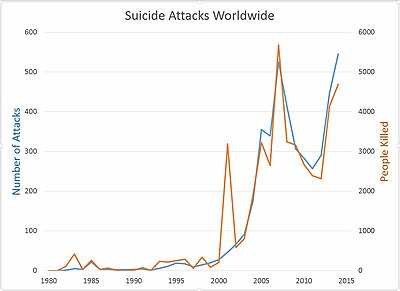自殺攻擊
此條目需要擴充。 (2015年8月18日) |
| 恐怖主義 |
|---|
| 定義 · 歷史 · 活動 · 事件 |
| 戰爭與軍事 |
|---|
自殺攻擊或稱自殺式襲擊、人肉炸彈,是一種將自殺擴大為傷害自己及目標者的行為,現代的自殺式攻擊通常是由自殺者在身上綁好炸彈,走到目標地,或是以裝滿炸彈的載具衝撞特定目標然後進行引爆,以達到傷害和宣傳信念的手段。自殺攻擊在歷史上屢見不鮮,在軍事衝突有諸如神風特攻隊這樣的例子,而在恐怖主義中最著名的案例則是911事件。
從第二次世界大戰結束到1980年間,世界上任何地方實施成功的自殺式襲擊都非常少,[1] 但從1981年到2015年9月,40多個國家共發生了4814起自殺式襲擊,造成45000多人死亡。[2] 在此期間,全球此類自殺式襲擊的發生率從1980年代的平均每年3起逐步增加到1990年的每月1起,[3] 而從2001年至2003年的每周1起則又逐步增加到2003年至2015年間每天1起。[2]
自殺式襲擊往往比其他恐怖襲擊更加致命也更具有破壞性,[4]因為這種襲擊方式能讓實施者隱藏襲擊武器,並在最終引爆才會被人發現,而且自殺式襲擊並不依賴遠程遙控、延遲爆炸、制定逃跑計劃或呼叫救援這些方式。[4]在1981年至2006年期間,自殺式襲擊僅佔全世界所有恐怖襲擊的4%,但造成的死亡人數卻佔所有與恐怖主義有關的死亡人數的32% (14599人)。而90%的自殺式襲擊發生在阿富汗、伊拉克、以色列、巴勒斯坦領土、巴基斯坦和斯里蘭卡。[5]截至2015年,約四分之三的自殺式襲擊都發生在阿富汗、巴基斯坦和伊拉克這三個國家。[6]
自殺式襲擊也會被作為一種心理戰武器,目的是向目標人群灌輸恐懼氛圍,[7] [8]瓦解「社會團結穩定安全」的結構和消除公眾對公共區域的安全感,也能表明實施者為實現其目標將不惜一切代價。[4]
自殺式襲擊有時可能有多種動機。神風特攻隊飛行員是完全服從軍事命令下行動的,而其他自殺式襲擊則是出於宗教或民族主義目的。據分析師羅伯特·佩普說,在2003年之前,大多數自殺式襲擊的目標都是佔領軍部隊。[9]人類學家斯科特·阿特蘭指出,自2004年以來,伊斯蘭的殉道意識激勵了絕大多數的自殺襲擊者。[10]
定義
[編輯]恐怖主義
[編輯]自殺式襲擊包括以恐怖活動形式的自殺式襲擊(通常被定義為「以恐嚇為主要目的」或「意圖造成平民或非戰鬥人員死亡或嚴重肢體傷害「的行動) ,也包括不針對非戰鬥人員的自殺式襲擊。[11]一名曾在伊斯蘭激進分子中生活過的記者賈森·伯克提出了另一個定義,他認為大多數人還將恐怖主義定義為「使用或威脅使用嚴重暴力」來推進某種「事業」,並強調恐怖主義只是一種推進其「事業」的手段策略。[12] 學者弗雷德·哈利迪曾寫道,將「恐怖分子「或者「恐怖主義」這兩個稱謂來賦予一個群體的行為也是一種策略,而恰好一些國家或者政府就會使用這種策略來否認反對派或者異議組織的「合法性「。[13]
自殺式恐怖主義
[編輯]
對於「自殺」的定義則是另外一個需要主要的問題。受政府聘用的教授艾米·佩達祖爾將自殺式恐怖主義本身定義為」意識到活着回來的幾率幾乎為零的人所犯下的暴力行為」,[15] 這裏包括了有自殺式的攻擊行為(如盧德國際機場掃射事件或戰場上的自殺衝鋒),[16][17]如果只關注真正意義上的「自殺襲擊」,那對於其生存幾率應該不是「接近於零」,而是等於零,因為"實施者要求任務成功的所需前提是必須確保自己能夠死亡。"。[16]
| 自殺 |
|---|
 |
著名自殺攻擊事件及人物
[編輯]- 參孫
- 良弼遇刺事件
- 神風特攻隊,第二次世界大戰時的日本部隊。
- 董存瑞炸碉堡
- 九一一事件
- 聯邦快遞705號班機
- 泰米爾之虎、阿爾蓋達組織、伊斯蘭國、博科聖地及塔利班等組織的成員。
- 兒玉譽士夫私宅襲擊事件
參考文獻
[編輯]- ^ Kay, Jonathan. Dying to Win: The Strategic Logic of Suicide Terrorism. Islam Daily. 13 September 2005 [5 October 2015].
- ^ 2.0 2.1 Chicago Project on Security and Terrorism. Suicide Attack Database. Cpostdata.uchicago.edu. [24 March 2016]. (原始內容存檔於24 January 2016).
- ^ Atran, Scott. The Moral Logic and Growth of Suicide Terrorism (figure 1, pg. 128) (PDF). sitemaker.umich.edu. [July 11, 2015]. (原始內容 (PDF)存檔於June 23, 2015).
- ^ 4.0 4.1 4.2 Hoffman, Bruce. The Logic of Suicide Terrorism. The Atlantic. June 2003 [4 October 2015]. (原始內容存檔於2022-06-21).
According to data from the Rand Corporation's chronology of international terrorism incidents, suicide attacks on average kill four times as many people as other terrorist acts.
- ^ Hassan, Riaz. What Motivates the Suicide Bombers?. YaleGlobal. Yale Center for the Study of Globalization. September 3, 2009 [November 2, 2012]. (原始內容存檔於October 4, 2013).
- ^ (Click "Search Database", then under "filter by", click "location". Afghanistan (1059) Iraq (1938) and Pakistan (490) have a total 3487 attacks out of a total of 4620 worldwide.)Year: 1982–2015. Group. Chicago Project on Security and Terrorism Suicide Attack Database. [2015-11-20]. (原始內容存檔於2016-01-24).
- ^ Hutchinson, W. The systemic roots of suicide bombing. Systems Research and Behavioral Science. March 2007, 24 (2): 191–200. doi:10.1002/sres.824.
- ^ de la Corte Ibáñez, Luis. The Social Psychology of Suicide Terrorism. ict.org.il. International Institute for Counter Terrorism. 19 October 2014 [22 December 2015]. (原始內容存檔於2022-01-21).
Terrorism involves the use of force or violence in order to instill fear as a means of coercing individuals or groups to change their political or social positions which means that social influence is the ultimate goal of terrorism. Obviously we could say the same about suicide terrorism. [...] An alternative perspective views terrorism, including suicide terrorism, as tool: a means to an end and a tactic of warfare that anyone could use.
- ^ For example, 90% of attacks in Iraq prior to the civil war (starting in 2003) aimed at forcing out occupying forces. Pape's tabulation of suicide attacks runs from 1980 to early 2004 in Dying to Win and to 2009 in Cutting the Fuse.
- ^ Scott Atran| The Moral Logic and Growth of Suicide Terrorism 互聯網檔案館的存檔,存檔日期June 23, 2015,. (pp. 131, 133); sitemaker.umich.edu; accessed July 11, 2015.
- ^ Definition given by Kofi Annan, March 2005 in the UN General Assembly, while Secretary General of the UN.Story: UN reform. United Nations. [2010-02-24]. (原始內容存檔於2007-04-27).
- ^ Jason Burke. Al-Qaeda: The True Story of Radical Islam. I.B.Tauris. 2004: 1–24 (22) [August 19, 2012]. ISBN 978-1-85043-666-9. (原始內容存檔於2022-06-12).
- ^ F. Halliday. (2002). Two Hours that Shook the World: September 11, 2001 – Causes and Consequences, Saqi; ISBN 0-86356-382-1, pp. 70–71
- ^ Number of suicide attacks and deaths from attacks 1982–2014. From Chicago Project on Security and Terrorism Suicide Attack Database (頁面存檔備份,存於互聯網檔案館)
- ^ Pedahzur, p. 8
- ^ 16.0 16.1 Yoram Schweitzer. Suicide Terrorism: Development and Characteristics. International Institute for Counter-Terrorism. April 21, 2000 [March 22, 2015]. (原始內容存檔於2013-05-27).
... a very specific kind of attack. It does not deal with the very high-risk terror operations that leave only little chance of survival to their perpetrators. Such attacks as the Japanese Red Army's (JRA) attack at Lod airport in 1972, Abu Nidal's attack on a synagogue in Istanbul in 1986 and the PFLP-GC hand-glider attack on an army barracks in Kiryat Shmona in 1987 fall outside the scope of this paper. Also excluded were the self-inflicted deaths of members of terrorist organization, ... a politically motivated violent attack perpetrated by a self-aware individual (or individuals) who actively and purposely causes his own death through blowing himself up along with his chosen target. ... the perpetrator's ensured death is a precondition for the success of his mission."
- ^ Dodd, Henry. A short history of suicide bombing. Action on Armed Violence. 23 Aug 2013 [6 October 2015]. (原始內容存檔於2020-09-07).
First of all let's be clear what kind of attacks we are talking about. Suicide bombings are those that involve the deliberate death of the perpetrator. We’re not just talking about a reckless charge in battle. The focus is on those attacks where the perpetrator functions as a sophisticated guidance system for the weapon. They function as part human and part weapon. In this way they are suicide attacks rather than suicidal attacks.
